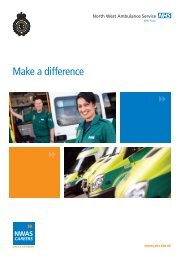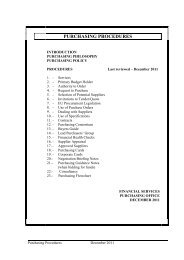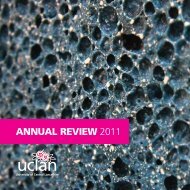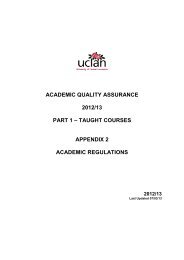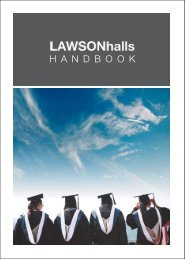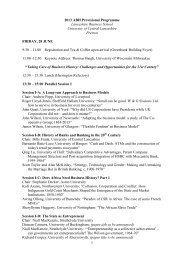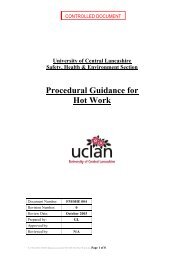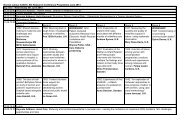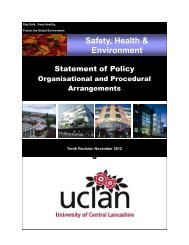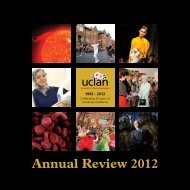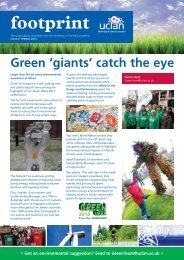5 Chinese Vietnamese Final - National Treatment Agency for ...
5 Chinese Vietnamese Final - National Treatment Agency for ...
5 Chinese Vietnamese Final - National Treatment Agency for ...
Create successful ePaper yourself
Turn your PDF publications into a flip-book with our unique Google optimized e-Paper software.
Issues surrounding drug use and drug<br />
services among the <strong>Chinese</strong> and <strong>Vietnamese</strong><br />
communities in England 5<br />
Jane Fountain<br />
Professor of Substance Use Research<br />
International School <strong>for</strong> Communities, Rights and Inclusion<br />
University of Central Lancashire, Preston, UK<br />
This is the fifth of a series of publications to in<strong>for</strong>m drug service planning and provision<br />
by presenting results from the Department of Health’s Black and minority ethnic drug<br />
misuse needs assessment project that was conducted throughout England in three<br />
phases during 2000-2001, 2004-2005, and 2006. This project employed the Centre <strong>for</strong><br />
Ethnicity and Health’s Community Engagement Model to train and support 179<br />
community organisations to conduct the needs assessments (Fountain, Patel and Buffin,<br />
2007; Winters and Patel, 2003). Each community organisation was also supported by a<br />
steering group whose membership included local drug service planners, commissioners<br />
and providers.<br />
This publication collates the findings from four reports from community organisations.<br />
Three of these are from <strong>Chinese</strong> community organisations and relate to issues<br />
surrounding drug use and drug services among 202 members of England’s <strong>Chinese</strong><br />
populations. One report is from a <strong>Vietnamese</strong> community organisation. This was the<br />
only of the 179 community organisations that participated in the project that was<br />
concerned with the <strong>Vietnamese</strong> population, which is one of England’s relatively small<br />
Black and minority ethnic populations. 113 community members took part in the study<br />
and a short report on the results is presented.<br />
1
Foreword<br />
This UCLAN series of reports – of which this is the fifth volume – examines knowledge<br />
of and in<strong>for</strong>mation about drugs and drug services among a range of Black and minority<br />
ethnic groups in England.<br />
Overall, the series has shown that various ethnic groups require more and better<br />
targeted in<strong>for</strong>mation which not only enables community members to understand the<br />
impact of drugs on their communities more fully but also helps them to access and to<br />
trust drug services when needed.<br />
The NTA endorses these reports.<br />
One of the questions which the reports did not set out to answer was whether – once<br />
they have entered drug treatment – drug users from Black and ethnic minority<br />
backgrounds have different treatment experiences and outcomes as a result of their<br />
ethnicity.<br />
An analysis of 2006/07 data from the <strong>National</strong> Drug <strong>Treatment</strong> Monitoring System<br />
(NDTMS) suggests that generally there is no ethnicity-related differential impact when it<br />
comes to drug treatment itself. 1 While different people respond to treatment differently,<br />
service user demographic characteristics do not have a major impact on the treatment<br />
provided to them – and this applies as much to gender and age as it does to ethnicity.<br />
The characteristics of the service provider and the service user’s main drug of use are<br />
more likely to affect how an individual responds to treatment.<br />
For instance, when compared to service users in general, Black service users (defined as<br />
Black Caribbean, Black African and ‘other’ Black) were half as likely in 2006/07 to be<br />
primary heroin users and five times more likely to be primary crack users.<br />
One of the functions of being a primary crack user was that they were also found to<br />
have shorter waiting times <strong>for</strong> drug treatment as well as shorter treatment episodes.<br />
These differential impacts were reflected among Black service users, but it is the crack<br />
use and not the ethnicity per se which is the stronger driver of any difference.<br />
As <strong>for</strong> discharge, the strongest factor which was linked to whether someone had a<br />
planned or unplanned discharge from treatment was also their drug of choice. In<br />
particular, the main factor that impacted negatively on planned discharge was the use<br />
of heroin and crack cocaine together, followed by opiate use alone then crack use<br />
alone.<br />
That said, the range of possible factors which can impact on treatment outcomes is so<br />
wide and varied that even the main drug of use is not a particularly strong driver.<br />
1<br />
This analysis is available on the NTA website at website at http://www.nta.nhs.uk/areas/<br />
diversity/docs/differential_impact_assessment_ndtms_0607_%20120309.pdf<br />
2
What this means <strong>for</strong> the treatment sector is that we may need to intensify our ef<strong>for</strong>ts to<br />
ensure that staff and organisational competence is sustained and enhanced to ensure<br />
that drug services meet the needs of a range of drug misusers.<br />
Evidence-based psychosocial interventions that promote freedom from dependence and<br />
a route towards recovery are of particular importance as the ‘golden thread’ that runs<br />
through all drug treatment. In turn, this will enable drug treatment services to improve<br />
their organisational functioning and have a greater impact on the outcomes of all their<br />
service users, whatever their ethnic background or primary drug of use.<br />
In accordance with the <strong>Agency</strong>’s Equality and Diversity Strategy, the NTA will there<strong>for</strong>e<br />
continue to conduct an annual analysis of the differential impact of drug treatment on<br />
different groups.<br />
3
Key messages<br />
Drug service needs<br />
• This report represents the evidence and recommendations <strong>for</strong> drug service planners,<br />
providers and commissioners to address the needs of <strong>Chinese</strong> and <strong>Vietnamese</strong><br />
people. To be effective, however, this work must take place at a local level, in order<br />
that the heterogeneity among and between these communities is addressed. ‘What<br />
works’ <strong>for</strong> those born in the UK, <strong>for</strong> example, may be inappropriate <strong>for</strong> recent<br />
immigrants.<br />
• The drug service needs presented in this report are interrelated: a ‘pick and mix’<br />
approach to meeting them will be ineffective because other barriers to drug service<br />
access will remain.<br />
• Meeting these needs relies not only on action by drug service planners,<br />
commissioners and providers, but also by the <strong>Chinese</strong> and <strong>Vietnamese</strong> communities<br />
themselves.<br />
• The overall picture painted by the results from the participation of 202 <strong>Chinese</strong> and<br />
113 <strong>Vietnamese</strong> people in the Department of Health’s Black and minority ethnic<br />
drug misuse needs assessment project is that they are dealing with drug use without<br />
sufficient knowledge of the issues and in isolation from mainstream drug services,<br />
and that drug services are unaware of the needs of these communities and of how<br />
to meet them. It is clear that community members want support and that drug<br />
services want to be supportive, but both lack the capacity to progress these aims.<br />
• The drug-related needs of the <strong>Chinese</strong> and <strong>Vietnamese</strong> communities are, above all,<br />
<strong>for</strong> in<strong>for</strong>mation about drugs and drug services. In addition, their trust in the cultural<br />
competence of drug services needs building up. Engagement between – and<br />
commitment from – <strong>Chinese</strong> and <strong>Vietnamese</strong> communities and local drug service<br />
planners, commissioners and providers is essential <strong>for</strong> progress towards meeting<br />
these needs.<br />
Patterns of drug use<br />
• The samples of <strong>Chinese</strong> and <strong>Vietnamese</strong> people from the four studies considered in<br />
this report were not representative of all members of these communities in England.<br />
Furthermore, the data on patterns of drug use were based on perceptions as well as<br />
on reported use. Nevertheless, the results indicate that:<br />
Among <strong>Chinese</strong> communities, cannabis and ecstasy are the most commonly used<br />
drugs, especially (but not exclusively) among young people. Heroin and cocaine<br />
powder are also used, but by far fewer <strong>Chinese</strong> people than use cannabis and<br />
ecstasy, and the use of other illicit drugs is relatively low.<br />
4
Cannabis is by far the most commonly used drug within the <strong>Vietnamese</strong><br />
community (followed by amphetamines). The use of other illicit drugs is relatively<br />
low. Young males are more likely to use drugs than females and other age<br />
groups. It was generally perceived that a greater proportion of <strong>Vietnamese</strong><br />
people in Vietnam use drugs than those in the UK.<br />
Help-seeking<br />
• The findings from the four community organisations’ studies strongly indicate that,<br />
compared to the white population, <strong>Chinese</strong> and <strong>Vietnamese</strong> people are underrepresented<br />
as recipients of drug in<strong>for</strong>mation, advice and treatment services. Indeed,<br />
drug service providers in the areas where the studies were conducted reported that<br />
they had very few – or no – clients from these communities.<br />
• The stigma of drug use prevents <strong>Chinese</strong> drug users from revealing to their families<br />
that they have a drug problem, and from attending a drug in<strong>for</strong>mation, advice or<br />
treatment service based in an area frequented by other <strong>Chinese</strong> people, because of<br />
the possibly of being recognised. If they do seek help, <strong>Chinese</strong> people are most likely<br />
to ask their GP.<br />
• <strong>Vietnamese</strong> people are reluctant to seek help with drug-related issues because they<br />
fear coming to the attention of the police, are reluctant to discuss any problems that<br />
affect their community, and lack trust in the confidentiality of drug services.<br />
In<strong>for</strong>mation needs<br />
• The major barrier to drug in<strong>for</strong>mation, advice and treatment services facing the<br />
<strong>Chinese</strong> and <strong>Vietnamese</strong> communities is a lack of knowledge about drugs and,<br />
especially, the range of drug services that exist and the help they can offer. This<br />
impedes access to in<strong>for</strong>mation and advice <strong>for</strong> all members of the communities,<br />
including non-problematic drug users who would benefit from in<strong>for</strong>mation about<br />
the substances they use and advice on harm reduction strategies. The lack of<br />
awareness also hinders access to treatment <strong>for</strong> problematic drug users, and means<br />
that, if treatment is accessed, there is an unrealistic expectation of what can be<br />
achieved and the process by which it is achieved.<br />
• If awareness-raising initiatives are to succeed, they must first overcome the<br />
reluctance of many <strong>Chinese</strong> and <strong>Vietnamese</strong> people to discuss drug-related issues<br />
because of the stigma attached to them.<br />
Cultural competence<br />
• A basic framework <strong>for</strong> cultural competence is provided in Section 6.<br />
• The study reports strongly recommended that drug service planners, commissioners<br />
and providers should understand and address how the cultures of the <strong>Chinese</strong> and<br />
5
<strong>Vietnamese</strong> communities affect access to drug in<strong>for</strong>mation, advice and treatment<br />
services in terms of:<br />
Language, including drug education materials in <strong>Vietnamese</strong> and the<br />
appropriate <strong>Chinese</strong> dialects, and drug service staff who speak these.<br />
The ethnicity of drug service staff, because <strong>Chinese</strong> and <strong>Vietnamese</strong> staff<br />
could explain the relevant culture and traditions to other staff, and their presence<br />
would encourage members of these communities to access drug services.<br />
The diversity of the <strong>Chinese</strong> population, which may comprise immigrants from<br />
mainland China, Hong Kong, Malaysia, Singapore and Taiwan; British-born<br />
<strong>Chinese</strong>; and children and young people temporarily living in the UK to study.<br />
Understanding diversity includes recognising the discreteness of England’s<br />
relatively small <strong>Vietnamese</strong> community and that it has a different culture and<br />
needs from the <strong>Chinese</strong> communities.<br />
Social exclusion, particularly of the <strong>Vietnamese</strong> community, as unemployment,<br />
a lack of English language skills and the consequent lack of integration are risk<br />
factors <strong>for</strong> drug use and problematic use.<br />
Engagement<br />
• The community organisations participating in the project stressed that partnerships<br />
between them and drug services were the way <strong>for</strong>ward to addressing the barriers to<br />
drug service access facing <strong>Chinese</strong> and <strong>Vietnamese</strong> people.<br />
• Adaptation, flexibility and commitment to engagement – by community members,<br />
community organisations and by drug service planners, commissioners and providers<br />
– are clearly required to ensure the success of such partnerships.<br />
• These partnerships are likely to be ‘starting from square one’ and face challenges<br />
that must be overcome – such as community members’ lack of trust in the<br />
confidentiality of drug services and a tendency to hide drug problems. There<strong>for</strong>e,<br />
increased access to drug services by members of the <strong>Chinese</strong> and <strong>Vietnamese</strong><br />
communities is unlikely to be an immediate outcome of partnership working.<br />
• Community organisations may need funding to increase their capacity to assist their<br />
communities with a range of drug-related needs and to fulfil their role as partners of<br />
drug services.<br />
Note<br />
As the community organisations reported both qualitative and quantitative data, this<br />
publication sometimes uses the following terms to give an indication of proportion:<br />
small minority (around 5% or less); minority (around 10%-15%); majority (more than<br />
50%); and large majority (more than 75%).<br />
6
Issues surrounding drug use and drug services<br />
among the <strong>Chinese</strong> communities in England<br />
The 2001 census reported that:<br />
Population profile<br />
• 0.4% (247,403) of the UK population were <strong>Chinese</strong>. [1]<br />
• <strong>Chinese</strong> people comprised 5.3% of the UK’s Black and minority ethnic population. [1]<br />
• In addition, 16,951 people in England and Wales reported their ethnicity as Mixed:<br />
<strong>Chinese</strong> and white; 1,422 as Mixed: Asian and <strong>Chinese</strong>; and 998 as Mixed: Black<br />
and <strong>Chinese</strong> (total 19,371 or 0.04% of the whole population). [2]<br />
• <strong>Chinese</strong> people <strong>for</strong>med more than 2% of the population in the London Boroughs of<br />
Barnet and Westminster and in Cambridge and the City of London. [3]<br />
• 22% of <strong>Chinese</strong> people in England and Wales described their religion as Christian<br />
and 15% as Buddhist. Over half (53%) stated that they had no religion. [4]<br />
• Of the <strong>Chinese</strong> people in Great Britain, 25% were born in England, and 3% in other<br />
UK countries, 29% in Hong Kong, 19% in China, 8% in Malaysia, 4% in Vietnam,<br />
3% in Singapore, 2% in Taiwan, and the remaining 7% in many other locations<br />
across the world. [5]<br />
Large-scale migration of <strong>Chinese</strong> people to the UK occurred in the 1960s, with<br />
economic migrants from Hong Kong, Malaysia and Singapore. Migration from mainland<br />
China began in the late 19 th century, but there has been a resurgence from the 1980s<br />
onwards (Dobbs, Green and Zealey, 2006).<br />
As one of the study reports noted, ‘The <strong>Chinese</strong> community in England is not a<br />
homogenous one. As a result of kinship, geographical and dialect links, subgroups have<br />
emerged’. The reports identified these as:<br />
• The immigrants in the 1960s from Hong Kong, Malaysia and Singapore, known as<br />
‘wah quil’ or ‘overseas <strong>Chinese</strong>’.<br />
• Immigrants from mainland China.<br />
• British-born <strong>Chinese</strong> (BBC).<br />
• Students: children and young people temporarily in the UK to study (at boarding<br />
schools, colleges and universities) from Hong Kong, China, Taiwan, Singapore and<br />
Malaysia.<br />
7
1 Research methods<br />
Data <strong>for</strong> the needs assessments were collected by <strong>Chinese</strong> community researchers who<br />
spoke the <strong>Chinese</strong> dialects of the target samples. They were selected by each<br />
community organisation and attended a series of accredited workshops run by the<br />
Centre <strong>for</strong> Ethnicity and Health (now part of the International School <strong>for</strong> Communities,<br />
Rights and Inclusion) on drugs and related issues (including drug policy) and on research<br />
methods.<br />
The samples were accessed using the community organisations’ and community<br />
researchers’ existing contacts with individuals and organisations (including places of<br />
worship) and snowballing from them. One study advertised <strong>for</strong> participants in <strong>Chinese</strong><br />
community centres, restaurants and supermarkets. The Centre <strong>for</strong> Ethnicity and Health’s<br />
Community Engagement Model’s use of researchers from the same communities as<br />
those being researched was there<strong>for</strong>e crucial to the data collection process. As one<br />
study reported noted:<br />
Had all these contacts and networks not existed, the research would have been<br />
near impossible. An outsider coming into the community could not have<br />
obtained the in-depth responses that have been accumulated.<br />
The community organisations used semi-structured questionnaires, focus groups and a<br />
small number of case studies of drug users to collect data. One of the <strong>Chinese</strong><br />
community organisations also observed <strong>Chinese</strong> people in a nightclub after being told<br />
by study participants that middle-aged men used ecstasy there.<br />
In the 2000-2001 phase of this project, a <strong>Chinese</strong> community organisation<br />
recommended a drug education package in <strong>Chinese</strong> dialects. This recommendation was<br />
taken up by another <strong>Chinese</strong> community organisation in 2005: three drug education<br />
workshops were held and pre- and post-workshop questionnaires were administered.<br />
Thus, the process by which these projects were delivered achieved one of the aims of<br />
the Centre <strong>for</strong> Ethnicity and Health’s Community Engagement Programme – to raise the<br />
awareness of community members of the issue in question.<br />
Two of the three study reports discussed how they had used different approaches to<br />
data collection with different elements of their samples. For example, one reported that<br />
young people were unwilling to attend focus groups in the community centre because<br />
‘authority figures’ may have been present, so small groups were conducted in a coffee<br />
bar. However, elderly people were happy <strong>for</strong> the groups to be held in the community<br />
centre because they felt relaxed there as they attended the centre’s luncheon club.<br />
These reports also discussed how some potential participants ‘were suspicious of the<br />
research motives and there<strong>for</strong>e unwilling to take part’, and so the community<br />
researchers had to stress the aims of the studies and that contributions would remain<br />
confidential.<br />
8
2 The <strong>Chinese</strong> sample<br />
• In total, 202 <strong>Chinese</strong> community members took part in the studies.<br />
• The sample’s age ranged from 16 to over 65, including 29% who were aged 16-25<br />
and 26% who were 50 or over.<br />
• 62% of the sample were female and 38% were male.<br />
• 152 study respondents were asked where they were born and their responses were:<br />
60% Hong Kong<br />
22% China<br />
13% Britain<br />
5% Singapore, Taiwan, Macau or Malaysia<br />
• The first language of the majority of the sample – especially among older people –<br />
was the <strong>Chinese</strong> dialect, Cantonese. The Hakka and Mandarin dialects were used by<br />
smaller proportions of the sample. Younger people were more likely to speak English<br />
as their first language, although many were also fluent in Cantonese, which they<br />
spoke at home.<br />
• The studies were conducted in areas where substantial proportions of <strong>Chinese</strong><br />
people live or visit: Greater Manchester and the London boroughs of Westminster,<br />
Camden and Islington. There are ‘Chinatowns’ in Westminster and in Manchester.<br />
• In addition to community members, two studies interviewed a total of 15<br />
professionals. Eight of these were workers from <strong>Chinese</strong> community organisations<br />
and seven were drug service workers.<br />
9
3 Patterns of drug use among the <strong>Chinese</strong> community<br />
See Key messages <strong>for</strong> a summary of this section<br />
It must be stressed that no inferences on the prevalence of illicit drug use<br />
among the <strong>Chinese</strong> communities should be made from the data presented in<br />
this section. The Department of Health’s Black and minority ethnic drug misuse needs<br />
assessment project was not intended to be a prevalence survey, but aimed to provide an<br />
overview of drug-using patterns and drug service needs. Indeed, only a small minority of<br />
the 202 <strong>Chinese</strong> study participants were asked directly about their personal drug use.<br />
There<strong>for</strong>e, in order to give an accurate as possible overview of patterns of drug use<br />
among <strong>Chinese</strong> people in England, this section combines the data on reported drug use<br />
with those of the perceptions of the study participants. The data from other publications<br />
in this series has shown that these perceptions concur with the reported drug use of the<br />
samples.<br />
• A majority of study participants agreed that illicit drugs were used among the<br />
<strong>Chinese</strong> communities that were studied <strong>for</strong> this project.<br />
• A small minority of study participants thought that young <strong>Chinese</strong> people do not use<br />
drugs because they ‘come from a professional family’, are ‘well educated’, are ‘good<br />
boys and girls and won’t go near drugs,’ and because ‘it’s discipline … you can see<br />
that some families have very good discipline … [and so] by the time they [young<br />
<strong>Chinese</strong> people] have friends who might have an influence on them, they are able to<br />
say no’.<br />
• One study reported that:<br />
Several participants talked about the ‘pill-taking disco culture’ as being a<br />
‘Western’ trend, implying that <strong>Chinese</strong> youngsters have been drawn in.<br />
Other participants in the study disagreed, however, and reported that the Hong<br />
Kong culture includes drug use in nightclubs by young people and that this<br />
continues among some of them when they move to the UK.<br />
• Cannabis and ecstasy (named in one report as fin tau yuen meaning head-shaking<br />
tablet) were perceived to be by far the most commonly used drugs, and use was<br />
reported by all age groups as ‘a normal activity’ <strong>for</strong> young people on a night out.<br />
One of the studies not only reported this from their sample, but also from items in<br />
<strong>Chinese</strong> newspapers, magazines and television programmes. A smaller proportion of<br />
the sample thought that heroin and cocaine powder were used by <strong>Chinese</strong><br />
people.<br />
• Only a very small minority of the sample thought that any other illicit drugs<br />
(amphetamines, ketamine, LSD and crack cocaine) were used among the <strong>Chinese</strong><br />
community. A few elderly people thought that opium may be used by older <strong>Chinese</strong><br />
people, although they acknowledged that this perception may be outdated.<br />
10
• With the exception of opium, the reported drug use of the sample corresponded to<br />
the above perceptions.<br />
• One study interviewed twelve professionals working in London, but they gave very<br />
little insight into drug use among this population. Only two of eight <strong>Chinese</strong><br />
community workers thought that drugs were used and four drug workers thought<br />
that heroin was the drug most commonly used, but reported that they had very few<br />
<strong>Chinese</strong> clients. Another study, in Manchester, reported that the three drug workers<br />
they interviewed ‘had little or no contact with drug users from the <strong>Chinese</strong><br />
community’ and lacked in<strong>for</strong>mation on the drug use among this population.<br />
• Overall, study participants felt that young <strong>Chinese</strong> people were more likely to use<br />
drugs – cannabis and ecstasy in particular – than other age groups, especially if they<br />
visited nightclubs. Heroin use was generally thought to be confined to older age<br />
groups. That said, one study reported that a minority of their sample of parents<br />
knew middle-aged men who used ecstasy in nightclubs: the study’s observation of<br />
this age group in a night club appeared to support these reports.<br />
• Peer influence was thought to be a major factor in influencing drug use by young<br />
people, followed by parents ‘neglecting’ their children because they work long<br />
hours. Unemployment, financial problems, stress, mental health problems and<br />
poverty were also perceived as risk factors <strong>for</strong> drug use among all age groups.<br />
3.1 Community members’ concerns surrounding illicit drug use<br />
Overall, when study participants were asked about their concerns surrounding illicit drug<br />
use, they concentrated on the problematic use (especially addiction) of heroin and crack<br />
cocaine. Thus, young people, many of whom used cannabis and ecstasy and described<br />
this as ‘normal’ behaviour, were intolerant of the use of other drugs, seeing it as<br />
harmful to health and characterised by addiction, gangs and crime, including mugging<br />
and other theft.<br />
Some adults said they avoided drug users because they were ‘scared – I keep my<br />
distance because they may cause damage to me’. Other adults, however, expressed<br />
sympathy and pity <strong>for</strong> dependent drug users.<br />
Study participants’ major concerns surrounding illicit drug use among the <strong>Chinese</strong><br />
community were that:<br />
• Drug use is increasing.<br />
• The reputation of the <strong>Chinese</strong> community, who ‘want face and reputation’ is<br />
adversely affected by drug use, and a drug user’s family is consequently stigmatised<br />
by their community. Indeed, one study reported that ‘Parents were very reluctant to<br />
talk about their children or personal experience. Fear of being labelled was a major<br />
factor’.<br />
11
• Drug use leads to crime to finance it, because drug users ‘will do all sorts of things<br />
to get money’:<br />
Crime rapidly increases, security becomes an issue in the sense that the elderly<br />
are afraid to walk the streets at night due to the increase of muggings etc.<br />
• Drug use is harmful to users’ physical and mental health, including addiction.<br />
Other concerns, reported by fewer study participants than those above, were that:<br />
• young people are exposed to drugs in school, nightclubs and casinos;<br />
• the Triads (described by one study report as ‘organised crime in Chinatown’) are<br />
involved in drug distribution;<br />
• drug use leads to the breakdown of family and friend relationships; and<br />
• drug use has a negative effect on users’ education, employment, careers and<br />
businesses.<br />
12
4 Help-seeking by the <strong>Chinese</strong> communities<br />
See Key messages <strong>for</strong> a summary of this section<br />
GPs were most commonly cited by study participants as the main source <strong>for</strong> drug<br />
in<strong>for</strong>mation, advice and treatment. They were followed by a wide variety of others –<br />
friends, <strong>Chinese</strong> community organisations, the media, schools and health centres. Drug<br />
services were rarely mentioned as a source of help, and then only by a few heroin<br />
and/or crack cocaine users.<br />
As discussed in Section 3, the drug service workers interviewed by two of the studies<br />
reported that they had very few <strong>Chinese</strong> clients. One of them believed that, <strong>for</strong> help and<br />
support with a drug problem, <strong>Chinese</strong> people:<br />
turn to their own – turn inwards rather than outwards. They’ll ask their own<br />
communities first.<br />
However, the study reports suggest that this assumption is not always correct, and that<br />
it rein<strong>for</strong>ces the stereotype of <strong>Chinese</strong> people summed up by one of the study reports as<br />
‘quiet … inscrutable … shy … self-sufficient … present an image of not causing any<br />
trouble’. The reports show that the stigma of drug use (Section 3.1) actually prevents<br />
<strong>Chinese</strong> drug users from revealing a drug problem to their families, as well as from<br />
attending a drug in<strong>for</strong>mation, advice or treatment service based in an area frequented<br />
by other <strong>Chinese</strong> people, because of the possibility of being recognised.<br />
The remaining sections report on the drug service needs of the <strong>Chinese</strong> communities as<br />
identified by the three community organisations. These strongly indicate that, compared<br />
to the white population, <strong>Chinese</strong> people are under-represented as recipients of drug<br />
treatment services.<br />
The <strong>Chinese</strong> communities’ drug service needs are categorised as in<strong>for</strong>mation on drugs<br />
and drug services, services’ cultural competence (especially in terms of language) and<br />
engagement. Of course, not all these needs apply exclusively to <strong>Chinese</strong> people, nor<br />
indeed only to members of Black and minority ethnic communities. Nevertheless, it does<br />
not follow that <strong>Chinese</strong> people can simply 'slot into' existing drug services. Responses<br />
may have to be different so that the barriers to drug service access that they face can be<br />
overcome.<br />
13
5 The <strong>Chinese</strong> communities’ in<strong>for</strong>mation needs<br />
See Key messages <strong>for</strong> a summary of this section<br />
In<strong>for</strong>mation about illicit drugs and drug services was identified by all the study reports as<br />
the <strong>Chinese</strong> communities’ major drug service need. Most study participants agreed that<br />
they wanted more in<strong>for</strong>mation on these issues. The small minority who did not, included<br />
parents who believed they did not need it because drug use would never affect them<br />
nor their families, and young people who insisted that they would never use drugs.<br />
5.1 Current knowledge<br />
All the studies reported that a large majority of their samples lacked knowledge about<br />
illicit drugs and drug services.<br />
Young people were somewhat more knowledgeable about illicit drugs than older<br />
generations, as the majority had received drug education at school. Other than this,<br />
young people’s main source of in<strong>for</strong>mation about drugs was the English media, whereas<br />
older generations cited the <strong>Chinese</strong> media. In summary, as one of the study reports put<br />
it:<br />
It would appear that apart from the mainstream schools, there is very little drug<br />
education available <strong>for</strong> the <strong>Chinese</strong> young people and their families.<br />
Knowledge of drug in<strong>for</strong>mation, advice and treatment services and the help they<br />
can offer was extremely limited across all age groups:<br />
We don’t really know where to go. There isn’t much in<strong>for</strong>mation available <strong>for</strong> the<br />
<strong>Chinese</strong> community. People with determination to quit drugs have nowhere to<br />
go.<br />
[<strong>Chinese</strong> drug users] do not know how to access help or what to expect from<br />
treatment. This alien situation results in a fear of the unknown and a reluctance<br />
to seek help.<br />
5.2 The message<br />
Study participants’ main suggestions <strong>for</strong> the content of drug education initiatives were<br />
<strong>for</strong> in<strong>for</strong>mation about illicit drugs, the drug services that are provided and how to access<br />
them. There were several suggestions that the stigma of drug use among the <strong>Chinese</strong><br />
communities could be reduced if this in<strong>for</strong>mation was presented as a health issue.<br />
Other suggestions were <strong>for</strong> in<strong>for</strong>mation on how parents can spot drug use among their<br />
children and how families can deal with the drug use of a member.<br />
14
Reflecting the perception that mental heath problems, unemployment and a lack of<br />
education are risk factors <strong>for</strong> drug use (Section 3), a large minority of study participants<br />
wanted in<strong>for</strong>mation about support with these issues to be provided alongside that on<br />
drugs. Some young people suggested that in<strong>for</strong>mation on sexual health should also be<br />
included.<br />
5.3 Media<br />
Study participants suggested various media in which they wanted in<strong>for</strong>mation about<br />
drugs and drug services. The most popular suggestions were:<br />
Bilingual leaflets in the appropriate <strong>Chinese</strong> dialects and English, designed <strong>for</strong><br />
each age group.<br />
Workshops <strong>for</strong> families in which the dialogue between generations and sharing<br />
of different views is encouraged. A large majority of study participants who<br />
attended drug awareness workshops held by one community organisation as part<br />
of this project agreed they had learned something about drugs and their effects,<br />
were willing to pass this in<strong>for</strong>mation onto others and wanted more workshops.<br />
Other common suggestions of how to transmit in<strong>for</strong>mation about drugs and drug<br />
services to the <strong>Chinese</strong> communities were:<br />
A <strong>Chinese</strong> telephone helpline because of its confidentiality, anonymity and<br />
‘because a lot of <strong>Chinese</strong> people may not speak English, a <strong>Chinese</strong> speaking helpline<br />
can help parents to get some emotional support and to talk about their<br />
worries’.<br />
In<strong>for</strong>mation by oral and visual media in <strong>Chinese</strong>, such as audiotapes, videos,<br />
DVDs and television programmes.<br />
Bilingual posters in public places.<br />
5.4 Venues<br />
Schools and community centres were the most frequently suggested venues <strong>for</strong> the<br />
transmission of in<strong>for</strong>mation about drugs and drug services.<br />
There was no consensus among young people who had received drug education at<br />
school as to whether or not this had been useful, but most of them and the adult study<br />
participants thought that schools should deliver more comprehensive in<strong>for</strong>mation, so<br />
that ‘kids can be aware of the dangers’ and ‘so they can make better judgement<br />
whether they should try it or not, other than being persuaded by peer pressure’.<br />
15
It was widely thought that in<strong>for</strong>mation and workshops about drugs and drug services<br />
should be available in <strong>Chinese</strong> community centres, because they were well-visited by<br />
the local <strong>Chinese</strong> population and because workers there could speak the relevant<br />
<strong>Chinese</strong> dialects.<br />
However, the study which interviewed eight workers from <strong>Chinese</strong> community<br />
organisations reported that the majority of these organisations did not provide<br />
in<strong>for</strong>mation on drugs, and that their workers had no drug training and were not aware<br />
of drug services. For example, although the youth leader in a <strong>Chinese</strong> community<br />
organisation thought drug education in schools was inadequate, he was not aware of<br />
any organisation other than the police that could provide a drug education workshop<br />
<strong>for</strong> young people. The study reported concluded:<br />
Community organisations demonstrated an alarming lack of<br />
awareness/understanding of drug-related issues and provision of drug support<br />
services and in<strong>for</strong>mation.<br />
Other less common suggestions were that in<strong>for</strong>mation should be made available in<br />
health centres, via peer education, and that drug service providers should distribute<br />
leaflets in Chinatowns and conduct outreach work, especially among young people.<br />
16
6 Cultural competence<br />
See Key messages <strong>for</strong> a summary of this section<br />
Cultural competency is a term that is being increasingly used within the public sector, but there is little agreement over<br />
what it means and how it can implemented. While most organisations conduct some training around race, culture and<br />
diversity, the content of their training programmes varies considerably (Tamkin et al., 2002). Moreover, the diverse<br />
meanings of ‘cultural competence’ are often highly dependent on local contexts:<br />
Cultural competency of care and services may be proposed in quite diverse ways depending on the local<br />
context. This mandates the need <strong>for</strong> careful research and quality checks on what is proposed and implemented<br />
and applied. (Bhui et al., 2007 p.14)<br />
There are no nationally recognised standards by which cultural competence can be measured, let alone defined.<br />
However, a basic framework <strong>for</strong> assessing cultural competence can still be developed. The following framework is<br />
intended as a guide and contains only examples of the various skills, processes and abilities that are involved.<br />
It is based on both individual and organisational competence. As detailed below, individual competence is skills-based<br />
and relates to individual practitioners’ professional practice in working with diverse communities and individuals.<br />
Organisational competence, on the other hand, is defined by the level of maturity in the organisation <strong>for</strong> addressing<br />
equality and diversity across the full range of its functions and policies.<br />
Individual competence<br />
Individual competence is based on the skills of acknowledging, accepting and valuing cultural difference in others –<br />
that is, between and among culturally diverse groups and individuals. Individual competence is built up through a<br />
developmental process that includes:<br />
• Improving knowledge of local communities, such as demographics, religious beliefs, sects and practices,<br />
common languages, migration and settlement patterns, health and social care needs, diet and cultural norms.<br />
• Developing skills in reflective practice including empathy, the ability to challenge assumptions and<br />
prejudices in self and others, and the ability to work through communication difficulties and differences with<br />
a sensitive aptitude and attitude.<br />
• Developing communication skills in working with people whose first language is not English and the ability<br />
to work sensitively and competently with interpreters.<br />
Organisational competence<br />
Organisational competence is demonstrated through a clear commitment to recognising diversity and the<br />
development of proactive policies which embed equality and skills in working with diverse communities throughout<br />
the organisation. This process includes:<br />
• A clear commitment to equality, valuing diversity and human rights, which is articulated in the aims and<br />
objectives of the organisation.<br />
• Provision of staff training programmes that meet the needs of a range of personnel, from basic induction<br />
through to higher-level learning.<br />
• A system <strong>for</strong> engaging and consulting with local communities and ensuring that services take account<br />
of local diversity.<br />
• Leadership and management of equality and diversity through per<strong>for</strong>mance and monitoring systems.<br />
It should be recognised that individual and organisational cultural competence are inter-dependent: one cannot be<br />
effective without the other. No matter how skilled or competent the individual, they require the support of the<br />
organisation in order to achieve effective cultural competence. Similarly, however well-developed an organisation’s<br />
policies and procedures are, it will fail to meet the needs of a culturally diverse population without skilled and<br />
competent staff to carry them out.<br />
Taking a maturity approach to cultural competence recognises that there are various levels through which individuals<br />
and organisation might pass as they move towards a fully-developed level of competence. This is also in keeping with<br />
models of lifelong learning and organisational development.<br />
17
A culturally competent service operates effectively in different cultural contexts so that<br />
the needs of all members of their target population can be met by equitable access,<br />
experience, and outcome. However, as one of the study reports put it, in the case of<br />
<strong>Chinese</strong> communities, there is also:<br />
a need <strong>for</strong> appropriate drug education – <strong>for</strong> young people, families and elders –<br />
in the appropriate language and culture. It also indicates a need <strong>for</strong> services to be<br />
more culturally appropriate. This includes appropriate literature, staffing and<br />
areas of work to access <strong>Chinese</strong> people.<br />
The issues discussed by study participants in relation to drug services’ cultural<br />
competence were the diversity within the <strong>Chinese</strong> population in England,<br />
language and the ethnicity of drug service staff.<br />
6.1 Diversity within the <strong>Chinese</strong> population<br />
The study reports emphasised that the diversity within a local <strong>Chinese</strong> population must<br />
be considered if services are to work towards cultural competence, because:<br />
For example:<br />
They come from various countries and background, have been in the UK <strong>for</strong><br />
different lengths of time and have varying levels of exposure to, and acceptance<br />
of, British culture and systems.<br />
Some young people are more English than <strong>Chinese</strong>. They hang out with English<br />
mates and wouldn’t even go to Chinatown that often. On the other hand, there<br />
are young people who are into Hong Kong culture and would go to Chinatown<br />
all the time and speak <strong>Chinese</strong> all the time and buy anything that’s related to the<br />
culture … BBC [British-born <strong>Chinese</strong>] can be seen as the same as English<br />
although they might have parents who are really traditional.<br />
Wah quil or overseas <strong>Chinese</strong> … do not speak English well … although England<br />
is their preferred place of settlement, they nevertheless grasp tightly onto<br />
ideologies they brought over from their ‘homeland’.<br />
6.2 Language and the ethnicity of drug service staff<br />
Study reports identified language as the biggest barrier to <strong>Chinese</strong> people – especially<br />
the older generations – obtaining in<strong>for</strong>mation about drugs and drug services. Only a<br />
small minority of the study participants reported ever seeing this in<strong>for</strong>mation in a<br />
<strong>Chinese</strong> dialect.<br />
18
The study participants whose first language was not English particularly stressed that<br />
they needed in<strong>for</strong>mation in the <strong>Chinese</strong> dialect that they used. They also wanted drug<br />
services to have more <strong>Chinese</strong> interpreters and workers so that they could deal with<br />
<strong>Chinese</strong> clients in a culturally competent manner:<br />
It is imperative that those who design and deliver drug in<strong>for</strong>mation and services<br />
have a deep understanding of <strong>Chinese</strong> culture and traditions … ideally being<br />
<strong>Chinese</strong> themselves.<br />
The drug service workers interviewed <strong>for</strong> one study reported that they had access to<br />
<strong>Chinese</strong> interpreters and/or workers who spoke different <strong>Chinese</strong> dialects. However,<br />
they added that there may be some delay in matching a <strong>Chinese</strong>-speaking client with an<br />
interpreter or worker who speaks the same dialect, during which time they cannot help<br />
potential clients, some of whom ended their contact with the service whilst waiting.<br />
19
7 Engagement with the <strong>Chinese</strong> communities<br />
See Key messages <strong>for</strong> a summary of this section<br />
The studies concluded that, be<strong>for</strong>e this project, drug services had given very little<br />
attention to the needs of <strong>Chinese</strong> communities:<br />
There was a strong feeling from the focus groups that nothing had been done<br />
<strong>for</strong> the <strong>Chinese</strong> community.<br />
Although … some ad hoc attempts had been made to work with <strong>Chinese</strong> drug<br />
users, these did not appear to be part of a strategic approach.<br />
We have found no instances of leaflets in the <strong>Chinese</strong> language…or employment<br />
of <strong>Chinese</strong> drug workers.<br />
The Department of Health’s Black and minority ethnic drug misuse needs assessment<br />
project has not only produced three local needs assessments from community<br />
organisations on the drug-related needs of the <strong>Chinese</strong> communities but has also<br />
engaged <strong>Chinese</strong> community organisations and local drug service planners,<br />
commissioners and providers. The study reports pointed out the value of this<br />
engagement <strong>for</strong> all those involved:<br />
[Local drug service providers] acknowledged their lack of experience and data<br />
about <strong>Chinese</strong> people and they were keen to gain any in<strong>for</strong>mation or assistance<br />
that we could provide.<br />
[The community researchers] developed an understanding of how services<br />
operated, adding to the research and drugs work skills and knowledge obtained<br />
through the project.<br />
I [a community researcher] never truly believed the skills would sustain in the<br />
community, as was hoped by the Department of Health and the Centre <strong>for</strong><br />
Ethnicity and Health. I guess you could say I was somewhat sceptical. However,<br />
as the needs assessment went on, my view changed as I could see that<br />
individuals on the team had become very enthusiastic, and have gained a great<br />
deal from the various aspects of the needs assessment – networking, doing the<br />
research, working in a community setting.<br />
20
7.1 Partnerships<br />
The study reports strongly recommended that partnerships between drug services and<br />
<strong>Chinese</strong> community organisations should be initiated, to ensure that drug in<strong>for</strong>mation,<br />
advice and treatment services are available to all members of the <strong>Chinese</strong> communities:<br />
We have found no instance of interagency team work with <strong>Chinese</strong><br />
organisations.<br />
I [a community researcher] have gained an insight into working with <strong>Chinese</strong><br />
organisations, including partnership and networking. This would be extremely<br />
useful <strong>for</strong> my future work when using a multi-agency approach in developing a<br />
drug service <strong>for</strong> the <strong>Chinese</strong> community.<br />
Given the poor racial equality record in statutory services, it is believed that the<br />
lead has to come from <strong>Chinese</strong> voluntary groups.<br />
7.2 Challenges<br />
The study reports identified several challenges facing drug services, <strong>Chinese</strong> community<br />
organisations and community members in order to achieve effective engagement:<br />
• The belief by community members that <strong>Chinese</strong> culture protects against drug use<br />
(Section 3).<br />
• A recognition by drug services of the influence and importance of the family in<br />
<strong>Chinese</strong> culture, and using this to ensure that the family’s involvement and support<br />
needs are ‘an inherent component of the drug treatment and support package’. For<br />
example:<br />
The western model of [individual] counselling does not suit the <strong>Chinese</strong> culture in<br />
terms of family support <strong>for</strong> drug use.<br />
[A drug worker’s] non-<strong>Chinese</strong> clients have very different needs to her <strong>Chinese</strong><br />
clients in terms of family. The families of her non-<strong>Chinese</strong> clients do not tend to<br />
get involved whereas the <strong>Chinese</strong> families need a lot of support. She added that<br />
the families obtain most of their in<strong>for</strong>mation from the media and that the<br />
in<strong>for</strong>mation they have is often inaccurate, so a lot of time has to be devoted to<br />
explaining the problems and treatments to the families.<br />
• Although London and Manchester – where the studies were conducted – have<br />
Chinatowns, most <strong>Chinese</strong> people do not live there, although they may visit<br />
regularly. Overall, the <strong>Chinese</strong> communities are, as one study report put it, ‘scattered<br />
across Britain because of their occupational concentration in the restaurant and<br />
catering trade’.<br />
21
This dispersal presents problems in terms of establishing a drug service in a<br />
Chinatown: commissioners are unlikely to fund a service that caters <strong>for</strong> those living<br />
outside the catchment area.<br />
• Although a majority of study participants wanted in<strong>for</strong>mation about drugs and drug<br />
services to be available in <strong>Chinese</strong> community centres, this is not currently provided<br />
by all these centres and the workers there have no training on these issues (Section<br />
5.4).<br />
7.3 Funding<br />
The study reports stressed that funding would be necessary to assist in the engagement<br />
process, specifically in terms of:<br />
• Drug education training <strong>for</strong> <strong>Chinese</strong> youth and community workers.<br />
• Leaflets giving in<strong>for</strong>mation about drugs and drug services in the locally used <strong>Chinese</strong><br />
dialects, to be distributed to the <strong>Chinese</strong> communities and available in GP surgeries,<br />
health centres and community centres.<br />
• Further research into the drug use and drug service needs of the <strong>Chinese</strong><br />
communities, utilising the skills the community researchers acquired during this<br />
project:<br />
What we have found I suppose is just the beginning, I am sure there is more to<br />
know about drug use in the community. We needed more time, we only just<br />
began uncovering.<br />
Until more <strong>Chinese</strong> people access services, we won’t know the extent of drug<br />
use. It is a lack of culturally appropriate services, rather than a lack of drug<br />
misuse in the community that partly explains this invisibility and the low uptake<br />
of services.<br />
22
Issues surrounding drug use and drug services<br />
among the <strong>Vietnamese</strong> community in England<br />
The 2001 census reported that:<br />
Population profile<br />
• 17,866 people in England and Wales were <strong>Vietnamese</strong>. [2]<br />
• 99% of these lived in England and 66% in London. [2]<br />
• <strong>Vietnamese</strong> people comprise 0.03% of the population in England and Wales [2] and<br />
0.4% of the UK’s Black and minority ethnic population. [1]<br />
It should be noted that the 2001 census statistics may not present an accurate picture,<br />
due to the compound nature of the questions on ethnicity that <strong>Vietnamese</strong> people had<br />
to complete. These were especially difficult <strong>for</strong> those who did not read and write English<br />
well. They had to tick an ‘other’ ethnic category and may not have followed the<br />
instructions to write in their ethnic background.<br />
23
8 Research methods<br />
Data <strong>for</strong> the needs assessment were collected by <strong>Vietnamese</strong> community researchers<br />
who spoke <strong>Vietnamese</strong>. The Centre <strong>for</strong> Ethnicity and Health’s Community Engagement<br />
Model’s use of researchers from the same communities as those being researched was<br />
crucial to the data collection process. Community researchers were selected by the<br />
community organisation and attended a series of accredited workshops run by the<br />
Centre <strong>for</strong> Ethnicity and Health on drugs and the related issues (including drug policy)<br />
and on research methods.<br />
The sample was accessed using the community organisation’s and community<br />
researchers’ existing contacts with individuals and organisations (including places of<br />
worship) and snowballing from there. During the study, local drug services asked the<br />
community organisation to provide translation services <strong>for</strong> two <strong>Vietnamese</strong> clients and<br />
these clients were recruited to the study.<br />
Data were collected using semi-structured questionnaires, focus groups and two case<br />
studies of drug users. The study reported some problems when holding a focus group<br />
<strong>for</strong> adults:<br />
As the subject [of drugs] was announced … some members showed signs of<br />
worry and refused to take part.<br />
Furthermore, those who remained refused to agree to the proceedings being taperecorded<br />
‘even though they were reassured that the discussion would be treated as<br />
strictly confidential’. The study report indicated that this reaction was partly due to the<br />
community’s concern of the involvement of members of the <strong>Vietnamese</strong> community in<br />
‘cannabis farms’ in England, about which media reports were circulating at the time of<br />
the study. For example, two focus group participants commented:<br />
Can we not talk about drugs in the UK? I don’t want to get into trouble, I cannot<br />
give you my opinion, I don’t want to grass on anyone … you know what<br />
problems we are facing at the moment.<br />
People are afraid to talk about drugs, particularly with what happened in the<br />
community in the last few months – nobody wants to get involved in drug<br />
related issues.<br />
Such a reaction underlines the community researchers’ view that they were embarking<br />
on a ‘taboo venture’ by conducting this study, and it is greatly to their credit that they<br />
devised and asked questions, and approached community members with sensitivity in<br />
order to maximise participation.<br />
24
9 The <strong>Vietnamese</strong> sample<br />
The study was conducted in five areas of Greater Manchester, which was identified as<br />
having a relatively large <strong>Vietnamese</strong> population. According to the 2001 census, only<br />
1,091 <strong>Vietnamese</strong> people lived in the whole of the north west of England [2] , although,<br />
as discussed in the ‘Population profile’ section, this is likely to be an underestimate.<br />
• The total sample of <strong>Vietnamese</strong> community members was 113.<br />
• The sample ranged in age from 16 to over 50, although 52% were under 25 years<br />
old and only 15% were 40 or older.<br />
• 57% of the sample were male and 43% were female.<br />
• 23 (20%) had been born in the UK. 42% had lived in the UK <strong>for</strong> five years or less<br />
and a third <strong>for</strong> over 10 years.<br />
• The main reasons those who were born elsewhere gave <strong>for</strong> migrating to the UK<br />
were ‘political’ (29%), ‘to join family’ (23%), ‘economic’ (17%) and ‘to study’ (9%).<br />
• 58% had British citizenship, 21% were asylum seekers, 10% were refugees and<br />
11% were visitors (including students).<br />
25
10 Patterns of drug use among the <strong>Vietnamese</strong><br />
community<br />
See Key messages <strong>for</strong> a summary of this section<br />
This section combines the perceptions of drug use in the <strong>Vietnamese</strong> community of 113<br />
community members and the reported drug use of 37 of them.<br />
It must be stressed that no inferences on the prevalence of illicit drug use<br />
among the <strong>Vietnamese</strong> community should be made from the data presented in<br />
this section. The Department of Health’s Black and minority ethnic drug misuse needs<br />
assessment project was not intended to be a prevalence survey, but aimed to provide an<br />
overview of drug-using patterns and drug service needs, and only one of the 179 needs<br />
assessments was concerned with the <strong>Vietnamese</strong> community. How typical the sample is<br />
of all <strong>Vietnamese</strong> people in England there<strong>for</strong>e cannot be assessed.<br />
10.1 Perceptions of drug use<br />
• 92% of the study participants thought that illicit drug use did occur within the<br />
<strong>Vietnamese</strong> community.<br />
• Almost two-thirds knew someone who had used, or was currently using illicit drugs.<br />
• A large majority of the sample thought that young <strong>Vietnamese</strong> males aged 16-21<br />
were more likely to use drugs than other age groups or females.<br />
• The main reasons <strong>for</strong> drug use among the <strong>Vietnamese</strong> community were perceived to<br />
be experimentation and boredom, followed by work-related stress and depression.<br />
• A large majority thought that pubs and clubs were the most likely venues where<br />
drugs would be used, and that schools and colleges were the least likely.<br />
• It was generally felt that more <strong>Vietnamese</strong> people in Vietnam used drugs than those<br />
in the UK. One explanation <strong>for</strong> this was that:<br />
In Vietnam it [drugs] is easier to get because of the language, it is their own<br />
country and culture, but whereas here it is difficult.<br />
10.2 Reported drug use<br />
One-third of the sample reported lifetime use of illicit drugs, representing 37<br />
participants – 35% of whom were aged over 30.<br />
• Cannabis was by far the drug most commonly used by these lifetime drug users:<br />
almost two-thirds (23) of them had used this drug.<br />
26
• 10 of the drug users (27%) had used amphetamines.<br />
• Fewer drug users had used other drugs: ecstasy (5 people), magic mushrooms (4<br />
people), heroin (3) and opium (3). Only one drug user had used poppers.<br />
• Ten (27%) of the lifetime drug users had used drugs in the last month.<br />
27
11 Help-seeking by the <strong>Vietnamese</strong> community<br />
See Key messages <strong>for</strong> a summary of this section<br />
Less than a third of the 37 drug users (11 people) reported that they had received advice<br />
about their use. The main source of this was friends, followed by a GP. Only two had<br />
accessed a drug service.<br />
Overall, two-thirds of the study participants thought that <strong>Vietnamese</strong> people would<br />
access drug in<strong>for</strong>mation, advice and treatment services ‘if they knew such things were<br />
available’. The study report also pointed out that, in addition to a lack of knowledge<br />
about drug services, barriers to help-seeking included a fear of coming to the attention<br />
of the police, a reluctance to admit to problems affecting their community and a lack of<br />
trust in the confidentiality of drug services:<br />
Sometimes, they may be hesitant or too worried that they may get troubles with<br />
the police, so they don’t admit they have been drug addicts.<br />
Through the research, it has become apparent that there is a lot of fear and<br />
apprehension when it comes to talking about the subject of drugs … There is<br />
also a sense of denial that there are drug issues within the <strong>Vietnamese</strong><br />
community as many <strong>Vietnamese</strong> people have turned away and shut themselves<br />
off from speaking about the problems that affect their community. This kind of<br />
behaviour has also increased in relation to a series of events that took place<br />
around the time that the research was being carried out [that is, the involvement<br />
of <strong>Vietnamese</strong> people in ‘cannabis farms’, as discussed in Section 8].<br />
The <strong>Vietnamese</strong> community have very little trust or no trust at all in the<br />
capabilities of drug services maintaining confidentiality. This is because members<br />
of the <strong>Vietnamese</strong> community are not accustomed to this type of working<br />
culture. There<strong>for</strong>e, <strong>Vietnamese</strong> drug users tend to hide their problems from<br />
others.<br />
Underlining the barriers to drug service access facing the <strong>Vietnamese</strong> community, the<br />
study reported that local drug services had very few – or no – clients from this<br />
population.<br />
28
12 The <strong>Vietnamese</strong> community’s drug service needs<br />
See Key messages <strong>for</strong> a summary of this section<br />
This section reports on the drug service needs of the <strong>Vietnamese</strong> community as<br />
identified by the community organisation on the basis of its study’s findings. These<br />
strongly indicate that <strong>Vietnamese</strong> people are in need of in<strong>for</strong>mation and advice on illicit<br />
drugs and on drug services, and, compared to the white population, are underrepresented<br />
as recipients of drug treatment services.<br />
The <strong>Vietnamese</strong> community’s drug service needs are categorised as in<strong>for</strong>mation on<br />
drugs and drug services, services’ cultural competence (especially in terms of<br />
language) and engagement. Of course, not all these needs apply exclusively to<br />
<strong>Vietnamese</strong> people, nor indeed only to members of Black and minority ethnic<br />
communities. Nevertheless, it does not follow that <strong>Vietnamese</strong> people can simply ‘slot<br />
into’ existing drug services. Responses may have to be different so that the barriers to<br />
drug service access that they face can be overcome.<br />
12.1 In<strong>for</strong>mation needs<br />
A large majority of the sample stressed that the <strong>Vietnamese</strong> community needed<br />
in<strong>for</strong>mation on drugs, drug services and drug-related issues. Young people thought this<br />
was particularly necessary <strong>for</strong> their own age group, as they are more likely than adults to<br />
have access to and to use drugs (although they recognised that adults may use drugs ‘as<br />
an escape from the reality and pressures of life’):<br />
When you go out to a club is when you are offered these things and I don’t think<br />
old people go to clubs that much.<br />
When asked how much they knew about a range of illicit drugs, a large majority<br />
reported that they knew ‘a little’ or ‘a lot’ about heroin, opium and cannabis. However,<br />
around half of the sample had ‘never heard’ of poppers, magic mushrooms and crack<br />
cocaine. The study report noted that ‘this is understandable, as these drugs are not<br />
available in Vietnam’.<br />
Around half of the sample perceived heroin and cocaine powder as the most harmful<br />
illicit drugs, and cannabis as the least harmful. However, the study report noted that:<br />
Most of the people admitted that they knew about the dangers of drug use in<br />
general, but the level of understanding of the effects that drugs have, mentally<br />
or physically, was minimal.<br />
Half of the study participants said they had some knowledge of illicit drug use in their<br />
local area. They reported television and other media as the main sources of this<br />
in<strong>for</strong>mation, followed by school.<br />
29
The sample’s knowledge of the location and nature of drug in<strong>for</strong>mation, advice and<br />
treatment services was extremely poor:<br />
I was told that treatment <strong>for</strong> drug users was to starve them [of drugs] … in a cold<br />
dark room – is that true?<br />
Only 16 study participants (14%) said that they knew of any service from which to seek<br />
help or advice on a drug-related problem.<br />
12.2 Cultural competence<br />
A basic framework <strong>for</strong> assessing cultural competence is provided in Section 6.<br />
The study report summed up the social exclusion of members of the Manchester<br />
<strong>Vietnamese</strong> population, who:<br />
are often misidentified as <strong>Chinese</strong> and their unique culture and needs have not<br />
been fully recognised. <strong>Vietnamese</strong> people are very isolated and there is not much<br />
integration between them and other communities … The majority of <strong>Vietnamese</strong><br />
in Manchester who fled Vietnam lived in North Vietnam under the communist<br />
regime … integrating into a multi-cultural society is a big change and a massive<br />
challenge <strong>for</strong> them … Their basic education levels are under the national<br />
education standards … Unemployment rates amongst <strong>Vietnamese</strong> are high …<br />
This particularly affects those who came to Britain when they were in their early<br />
40s or older.<br />
Several study participants commented that the consequence is that traditional<br />
<strong>Vietnamese</strong> culture is disappearing among the <strong>Vietnamese</strong> community in the UK:<br />
The <strong>Vietnamese</strong> culture has changed so much due to the transition from Vietnam<br />
to the UK and this has had a massive impact on the behaviour of <strong>Vietnamese</strong><br />
people.<br />
When I first came over to England, New year and Children festivals was alright<br />
but suddenly it gone smaller and smaller … Be<strong>for</strong>e, me and my sister used to<br />
dance <strong>for</strong> the <strong>Vietnamese</strong> community, but now it’s all gone and we don’t hear<br />
about them [<strong>Vietnamese</strong> festivals] anymore.<br />
Some commented that the relatively small size of the <strong>Vietnamese</strong> community in the UK<br />
when compared to <strong>Chinese</strong> communities also contributed to their disappearing culture:<br />
I think that <strong>Chinese</strong> is a lot more popular than <strong>Vietnamese</strong> community, ‘cos there<br />
are a lot more of them.<br />
The people as a whole seem to have been undermined due to the fact that their<br />
community is one of the smallest in Britain and that the <strong>Chinese</strong> community<br />
outnumbers them.<br />
30
The <strong>Chinese</strong> New year is so nice and big, and any other event they [<strong>Chinese</strong><br />
people] make sure you will know about it, while the <strong>Vietnamese</strong> events are too<br />
small.<br />
12.2.1 Language and the ethnicity of drug service staff<br />
It was clear from the study report that the majority of study participants were not fluent<br />
in English and that most wanted in<strong>for</strong>mation about drugs and drug services in<br />
<strong>Vietnamese</strong>. However, only two participants said that they had obtained this – one from<br />
a GP and the other from a <strong>Vietnamese</strong> newspaper – and although the study reported<br />
that some local drug services had produced in<strong>for</strong>mation leaflets in various languages,<br />
<strong>Vietnamese</strong> was not one of them. As one study participant commented:<br />
If they don’t understand English or read English, where are you going to get the<br />
help from?<br />
Leaflets in <strong>Vietnamese</strong> were considered essential by the study participants, because, as<br />
one of them put it:<br />
<strong>Vietnamese</strong> people are quite shy, they don’t want people to know their problem<br />
and so a leaflet in <strong>Vietnamese</strong> is a good first step.<br />
The study report recommended that drug services in areas where there was a<br />
<strong>Vietnamese</strong> population should recruit a <strong>Vietnamese</strong> worker (‘so that the people who go<br />
there <strong>for</strong> help do not feel alienated’) in order to:<br />
• translate <strong>for</strong> those <strong>Vietnamese</strong> clients who do not understand English;<br />
• explain the service’s processes and procedures to <strong>Vietnamese</strong> clients;<br />
• conduct outreach work among the <strong>Vietnamese</strong> community;<br />
• create and maintain links between the <strong>Vietnamese</strong> community and local drug<br />
services; and<br />
• assist local drug services to develop a strategy to raise the awareness of the<br />
<strong>Vietnamese</strong> community about drugs and drug services.<br />
31
12.3 Engagement<br />
The community organisation conducting this needs assessment said that it was the only<br />
organisation in the whole of Greater Manchester providing support and services to the<br />
<strong>Vietnamese</strong> community – through cultural activities, a community development<br />
programme, training <strong>for</strong> employment, interpretation and translation, the provision of<br />
in<strong>for</strong>mation about welfare benefits and social issues, and by promoting social<br />
integration.<br />
The organisation delivered some services in partnership with others, and indicated a<br />
willingness to continue this approach with local drug services: indeed, they had provided<br />
translation services <strong>for</strong> two of these.<br />
A partnership between the community organisation and local drug services was stressed<br />
as the way <strong>for</strong>ward, so that it could begin to address the main issues identified by the<br />
study report: the <strong>Vietnamese</strong> community’s lack of awareness of drugs and drug services,<br />
and the barriers they face to accessing drug in<strong>for</strong>mation, advice and treatment.<br />
32
Notes<br />
[1] (accessed May<br />
2008)<br />
[2] Calculated from census data provided by Office <strong>for</strong> <strong>National</strong> Statistics, March 2008 (M221bNat-to-<br />
Gor.xls: Ethnic group – detailed categories based on ethnic write-in).<br />
[3] (accessed May 2008)<br />
[4] Calculated from Census 2001, Table S104 (ethnic group by religion).<br />
(accessed September 2007).<br />
[5] Dobbs, J. Green, H. Zealey, L. (2006) <strong>National</strong> statistics: focus on ethnicity and religion. <strong>National</strong><br />
Statistics. Basingstoke, Palgrave Macmillan.<br />
References<br />
Bhui, K. Warfa, N. Edonya, P. McKenzie, K. Bhugra, D. (2007) Cultural competence in mental health care:<br />
a review of model evaluations. BMC Health Services Research, 7(1).<br />
Dobbs, J. Green, H. Zealey, L. (2006) <strong>National</strong> statistics: focus on ethnicity and religion. <strong>National</strong> Statistics.<br />
Basingstoke, Palgrave Macmillan.<br />
Fountain, J. Patel, K. Buffin, J. (2007) Community engagement: The Centre <strong>for</strong> Ethnicity and Health<br />
model. In Domenig, D. Fountain, J. Schatz, E. Bröring, G. (eds.) Overcoming barriers: migration,<br />
marginalisation and access to health services. Amsterdam, Amsterdam Oecumenisch Centrum (AMOC) /<br />
Correlation network <strong>for</strong> social inclusion and health, pp.50-63.<br />
Tamkin, J. Ashton, J. Cummings, J. Hokker, H. Pollard, E. Rick, J. Sheppard, E. Tackey ND (2002) A review<br />
of training in racism awareness and valuing cultural diversity. RDS on-line report 09/02. London, Home<br />
Office.<br />
(accessed February 2008)<br />
Winters, M. Patel, K. (2003) The Department of Health’s Black and minority ethnic drug misuse needs<br />
assessment project. Report 1: the process. Preston, Centre <strong>for</strong> Ethnicity and Health, University of Central<br />
Lancashire.<br />
For further in<strong>for</strong>mation, contact:<br />
iscrioffice@uclan.ac.uk<br />
JFountain1@uclan.ac.uk<br />
Acknowledgements<br />
The author thanks Jez Buffin and Jon Bash<strong>for</strong>d (International School <strong>for</strong> Communities, Rights and<br />
Inclusion, University of Central Lancashire) and Oswin Baker (<strong>National</strong> <strong>Treatment</strong> <strong>Agency</strong> <strong>for</strong> Substance<br />
Misuse) <strong>for</strong> their assistance with the preparation of this publication. The community organisations whose<br />
needs assessment reports provided the data <strong>for</strong> it are also gratefully acknowledged:<br />
<strong>Chinese</strong> Health In<strong>for</strong>mation Centre<br />
Manchester <strong>Vietnamese</strong> Refugee Community<br />
Association (MVRCA)<br />
<strong>Chinese</strong> Healthy Living Centre in partnership with<br />
the Hunger<strong>for</strong>d Drug Project<br />
Wai Yin <strong>Chinese</strong> Women Society<br />
33



